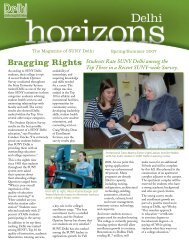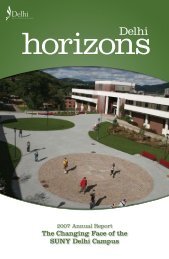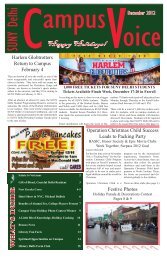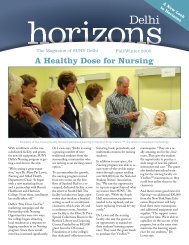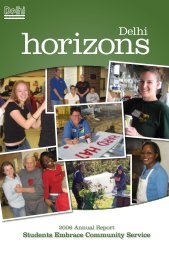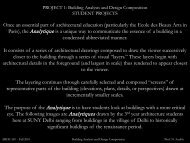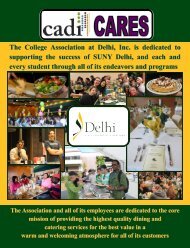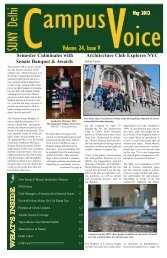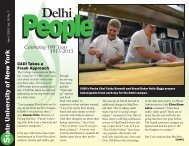You also want an ePaper? Increase the reach of your titles
YUMPU automatically turns print PDFs into web optimized ePapers that Google loves.
14<br />
3) Buy products with minimal<br />
plastic packaging or buy in bulk.<br />
Choosing products with less packaging<br />
is not only good for the environment,<br />
but it is less costly for manufacturers.<br />
Another step that you might<br />
take is to write to the manufactures of<br />
your favorite products to encourage<br />
them to use less packaging or more<br />
environmentally friendly packaging.<br />
4) Buy products made or packaged<br />
with recycled materials. Buying<br />
these goods supports recycling efforts.<br />
If you have reduced your plastic<br />
waste and are wondering what else<br />
you can do, recycling plastic from<br />
consumable everyday items should<br />
be the next step. Here in Delaware<br />
County, only clean (rinsed) #1 and #2<br />
plastic containers with necks can be<br />
recycled, for example beverage bottles<br />
and detergent containers. Check the<br />
Campus Recycling Guide available at<br />
http://www.delhi.edu/administration/<br />
facilities/recycle/ for detailed information<br />
on recycling of plastic and other<br />
materials. Statistical data from www.<br />
greenerchoices.org indicate that about<br />
25% of #1 and #2 plastic were recycled<br />
in 2006, so there is a lot of room<br />
for improvement. But what exactly do<br />
all of those recycling numbers mean,<br />
anyway?<br />
Chemically speaking, the word “plastic”<br />
refers generally to many different<br />
compounds with different properties.<br />
Most plastics are primarily composed<br />
of the elements carbon and hydrogen,<br />
but they may also contain smaller<br />
amounts of oxygen, nitrogen, chlorine,<br />
sulfur, and/or silicon. However, all<br />
plastics are polymers, which are large<br />
molecules made of smaller subunits<br />
called monomers. To create the plastic<br />
polymers, petroleum products are<br />
heated under controlled conditions,<br />
which creates plastic monomer units,<br />
and then the monomers are allowed to<br />
join together to produce the polymer.<br />
The properties of the plastic material,<br />
such as strength or fl exibility, depend<br />
on which monomers are used and how<br />
they are joined together with heat and<br />
pressure. Essentially, it is like making<br />
a chain, and the properties of the chain<br />
depend on which links are hooked<br />
together. The resin identifi cation code<br />
(the recycling number printed on the<br />
plastic container) serves to classify the<br />
type of plastic so that its properties<br />
may be known, and these codes are<br />
briefl y described below.<br />
Resin identifi cation code #1 indicates<br />
a type of plastic called polyethylene<br />
LA, cont’d from pg. 13<br />
technology to end our addiction to oil.<br />
Toward the end of the speech, Jindal says<br />
that we must promote confi dence in America<br />
by having the most transparency system<br />
in the world. He points to how his state<br />
has passed the strongest ethics laws recently.<br />
He said that transparency was necessary<br />
so that “we never see the passage<br />
of another trillion dollar spending bill…”<br />
First, I could hardly believe that he was<br />
bringing transparency into the question<br />
when Obama has strived for transparency<br />
terephthalate (PET or PETE), which<br />
has properties of clarity, strength,<br />
toughness, and is a good barrier to<br />
gas and moisture. PET plastic is the<br />
most common for single-use bottled<br />
beverages, because it is inexpensive,<br />
lightweight and easy to recycle.<br />
Examples of PET containers include<br />
soda bottles, water bottles, peanut<br />
butter jars, salad dressing bottles, and<br />
other similar containers. As mentioned<br />
before, PET is accepted in most<br />
recycling programs, and it is commonly<br />
recycled into polar fl eece, fi ber,<br />
tote bags, furniture, carpet, paneling,<br />
straps, and new containers (occasionally).<br />
Recycling rates remain relatively<br />
low (around 20-25%), though the<br />
recycled material is in high demand by<br />
manufacturers.<br />
Resin identifi cation code #2 is for high<br />
density polyethylene (HDPE), which<br />
has properties of stiffness, strength,<br />
toughness, resistance to moisture, and<br />
permeability to gas. HDPE has many<br />
uses, especially in packaging of common<br />
items like milk, bleach, household<br />
cleaner, shampoo, butter, cereal,<br />
and motor oil. Again, high density<br />
polyethylene is accepted in most<br />
recycling programs, although some<br />
programs only allow containers with<br />
necks (such as Delaware County).<br />
HDPE may be recycled into detergent<br />
bottles, pens, recycling containers,<br />
fl oor tile, drainage pipe, doghouses,<br />
picnic tables, and fencing.<br />
Resin identifi cation code #3 is for<br />
polyvinyl chloride (PVC), which has<br />
properties of versatility, clarity, ease<br />
of blending, strength, and toughness.<br />
PVC is commonly used in detergent<br />
bottles, cooking oil bottles, clear food<br />
packaging, medical equipment, siding,<br />
windows, and pipes. PVC is tough<br />
and weathers well, so it is commonly<br />
used for siding and similar applications.<br />
Polyvinyl chloride is rarely<br />
recycled, but is accepted by some<br />
manufacturers to be converted into<br />
decking, paneling, mudfl aps, fl ooring,<br />
cables, and mats. However, PVC<br />
contains the element chlorine, which<br />
makes the manufacturing process involve<br />
dangerous chemicals. Furthermore,<br />
the chlorine content is also the<br />
reason why PVC should not be burned<br />
or allowed to touch food during cooking<br />
(or microwaving), because harmful<br />
substances can be released.<br />
Resin identifi cation code #4 is for low<br />
density polyethylene (LDPE), which<br />
has properties of ease of processing,<br />
strength, toughness, fl exibility, ease<br />
of sealing, and is a good barrier to<br />
ever since he has been in offi ce. Not only<br />
did Obama apologize for the recent Tom<br />
Daschle tax debacle, but there is a website<br />
made to track the money being spent under<br />
the stimulus bill: recovery.gov. Second, I<br />
must say that I am glad that the stimulus<br />
package went through. Jindal and Republicans<br />
say that this is a burden that we are<br />
irresponsibly putting on our children, but I<br />
say: how will we raise our children without<br />
money? Time will tell how well the recovery<br />
bill will pull us out of this rut. Unlike<br />
Rush Limbaugh, I’m hoping for its suc-<br />
Plastic Recycling<br />
moisture. LDPE is fl exible and commonly<br />
used for squeezable bottles,<br />
bread bags, shopping bags, clothing,<br />
furniture, and carpet. LDPE is not<br />
usually recycled, with the exception<br />
of shopping bags, but more recycling<br />
programs are accepting it. Recycled<br />
LDPE can be converted into trash can<br />
liners, compost bins, shipping envelopes,<br />
paneling, landscaping tiles, and<br />
fl oor tile.<br />
Resin identifi cation code #5 is for<br />
polypropylene (PP), which has properties<br />
of strength, toughness, resistance<br />
to heat/chemicals/grease & oil, versatile,<br />
and is a good barrier to moisture.<br />
Polypropylene has a high melting<br />
point, and is good for containers that<br />
must accept hot liquid. Examples of<br />
PP uses include yogurt cups, syrup<br />
bottles, ketchup bottles, caps, straws,<br />
and medicine bottles. Polypropylene<br />
is occasionally recycled (becoming<br />
more accepted), but may be converted<br />
to brooms, brushes, ice scrapers,<br />
rakes, bins, and trays.<br />
Resin identifi cation code #6 is for<br />
polystyrene (PS), which is probably<br />
more easily recognized by the brand<br />
name Styrofoam® (although polystyrene<br />
can also exist as a harder, less airfi<br />
lled plastic). Polystyrene is versatile<br />
and easily formed, which makes it<br />
useful for disposable plates and cups,<br />
meat trays, egg cartons, carry-out containers,<br />
and packing material. Many<br />
places will not accept PS for recycling<br />
because it has a bad reputation for being<br />
diffi cult to recycle, but it is slowly<br />
gaining support. Polystyrene may be<br />
recycled into insulation, light switch<br />
plates, egg cartons, vents, rulers, foam<br />
packing, and carry-out containers.<br />
Polystyrene has a low melting point<br />
and should not be strongly heated<br />
(including the microwave) or burned,<br />
because it can release harmful breakdown<br />
products.<br />
Resin identifi cation code #7 is the<br />
category for a variety of plastics that<br />
do not fi t into the categories #1-6, thus<br />
#7 plastic is given the name “other.”<br />
Number 7 plastics are commonly used<br />
for water bottles, bullet-proof materials,<br />
sunglasses, DVDs, computer<br />
cases, signs, and food containers.<br />
Number 7 plastics have traditionally<br />
not been recycled, but may be recycled<br />
into plastic lumber and other custom<br />
products. Acrylonitrile butadiene<br />
styrene (ABS) is one type of plastic<br />
that is in the #7 category, and common<br />
examples of products are plastic clarinets,<br />
golf club heads, protective head<br />
gear, and Lego® bricks. Although<br />
cess.<br />
If it is not obvious yet, let me state that I<br />
am a registered Democrat voter and I side<br />
to the far left. I am for bigger government,<br />
and although I’m not an economist by any<br />
means, I do believe that the Reagonomics<br />
trickle-down (while-the-government-doesalmost-<br />
nothing) theory will not work for<br />
the US especially now. The best part of<br />
Jindal’s otherwise unsuccessful speech was<br />
at the end when he says, “it comes down to<br />
an honest and fundamental disagreement<br />
about the proper role of government…our<br />
<strong>MAR</strong>CH 20<strong>09</strong><br />
uncommon, polyactide is a type of #7<br />
plastic that is compostable because<br />
it is made from lactic acid, which is<br />
found in milk or may be fermented<br />
from corn starch. However, you may<br />
be more familiar with lactic acid as<br />
the stuff that makes your muscles<br />
sting after running for too long. Polycarbonate,<br />
which is hard and clear, is<br />
the other large contributor to plastics<br />
in this category.<br />
So just what happens to all of that recycled<br />
plastic after you put it in a bin<br />
somewhere? Well, the plastic materials<br />
are collected and go to a material<br />
recovery center where they are sorted<br />
manually and/or mechanically into<br />
bins by their plastic type. The gargantuan<br />
piles of recyclables are then baled<br />
together and sent to a reclaiming facility,<br />
where the scrap plastic is washed<br />
and ground into fl akes. A fl otation<br />
tank is then used to remove other<br />
contaminants (based on density), and<br />
the fl akes are dried, melted, fi ltered,<br />
and formed into pellets. These pellets<br />
are then sold and shipped to product<br />
manufacturing plants, where they<br />
are made into new plastic products.<br />
Thanks to plastic recycling, fewer raw<br />
materials and less energy are needed<br />
to make new plastic products, and<br />
that is something we all can be proud<br />
about.<br />
If you have been exposed to any<br />
form of recycling propaganda before,<br />
you probably have heard the phrase<br />
“Reduce, Reuse, Recycle.” So here<br />
we are, nearing the conclusion of this<br />
article, and if you have been paying<br />
close attention, you have probably noticed<br />
that I have addressed both reduce<br />
and recycle but not reuse. The reason<br />
for this blatant omission of conventional<br />
recycling wisdom is due to the<br />
growing controversy over whether or<br />
not plastic food/drink containers are<br />
leaching harmful chemicals into the<br />
very food and drink that we consume.<br />
Particularly, some people are worried<br />
that polycarbonate (#7) may leach a<br />
potential hormone disruptor called<br />
Bisphenol-A. All that I will say right<br />
now is that this truly is a controversy<br />
(although I tend to lean on the side<br />
that it is more hype than a true concern).<br />
However for non-food uses,<br />
my offi cial position is that reusing<br />
plastic items is a great way to contribute<br />
to the recycling effort. That’s all<br />
for now, but be sure to stay tuned and<br />
watch for my next article in order to<br />
make the decision for yourself if it is<br />
a good idea to reuse plastic containers<br />
for food or is it all just “hippie hype.”<br />
party got away from its principles…Republicans<br />
went along with earmarks and<br />
big government spending in Washington.”<br />
I agree with Jindal’s assessment of is own<br />
party’s situation, and it should be interesting<br />
to see the direction of the party. Will we<br />
see more far right minorities and far right<br />
republicans in general leading the way or<br />
a rise in successful moderate conservative<br />
voices? I hope it is the latter. While bipartisanship<br />
is nice, it has been and will be<br />
diffi cult to attain if we want real change.








